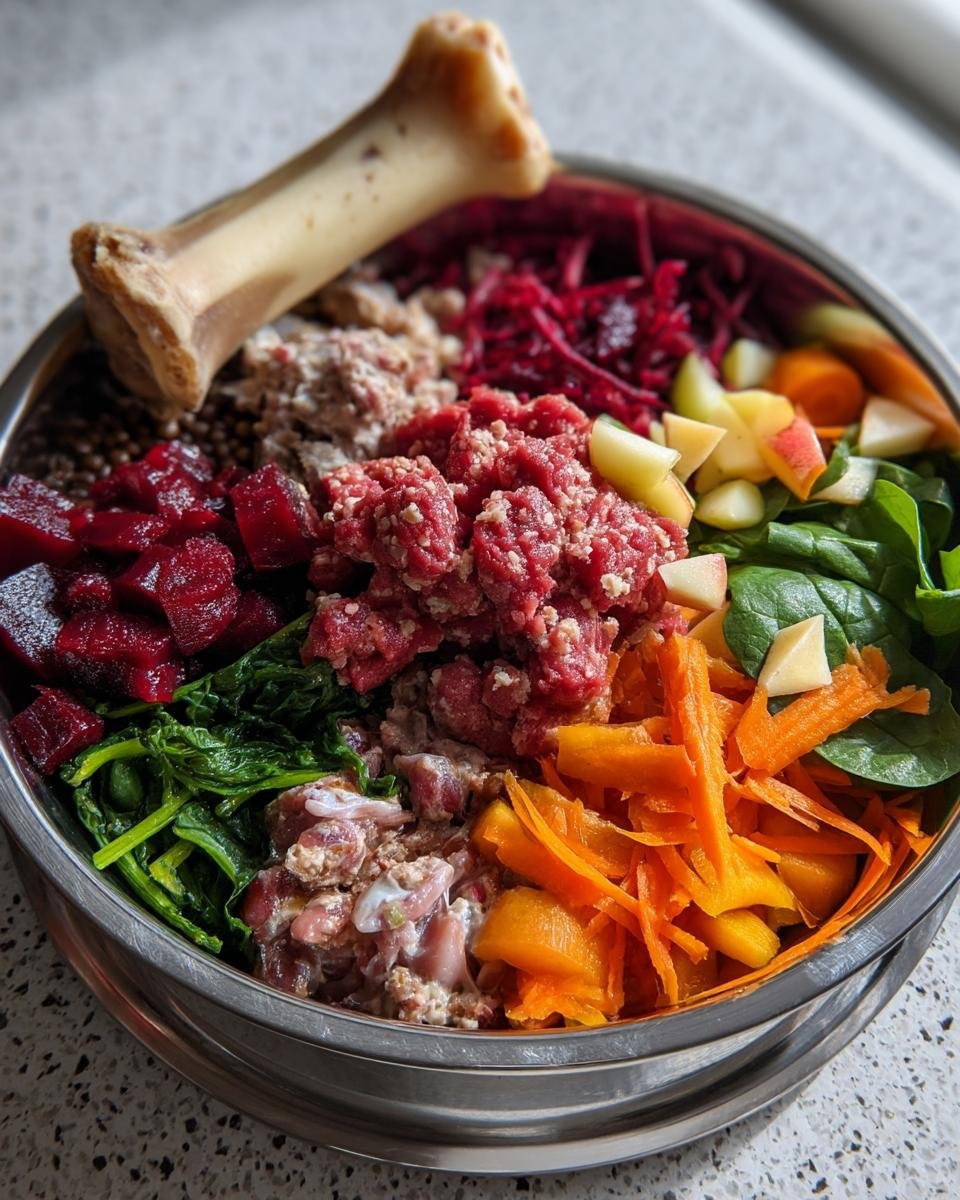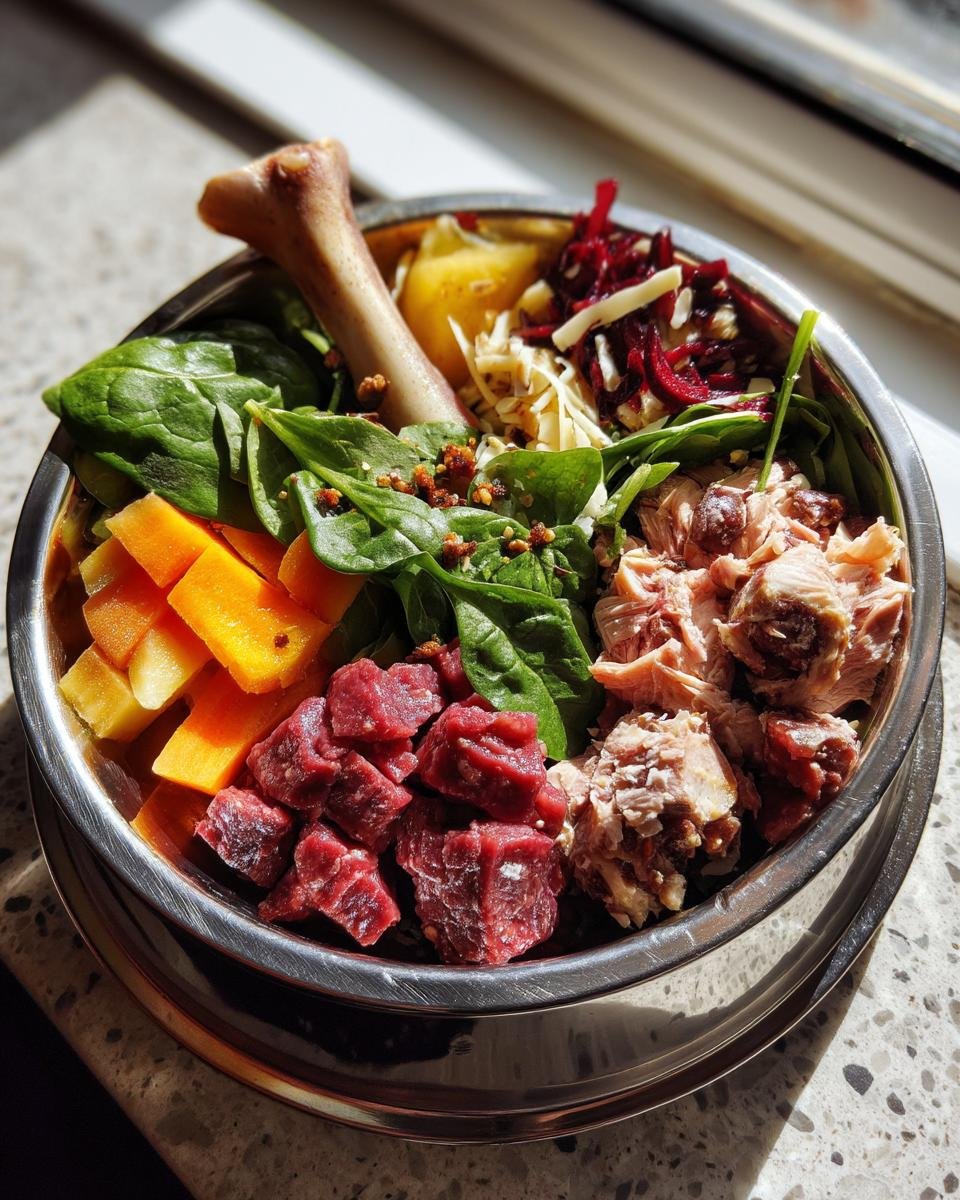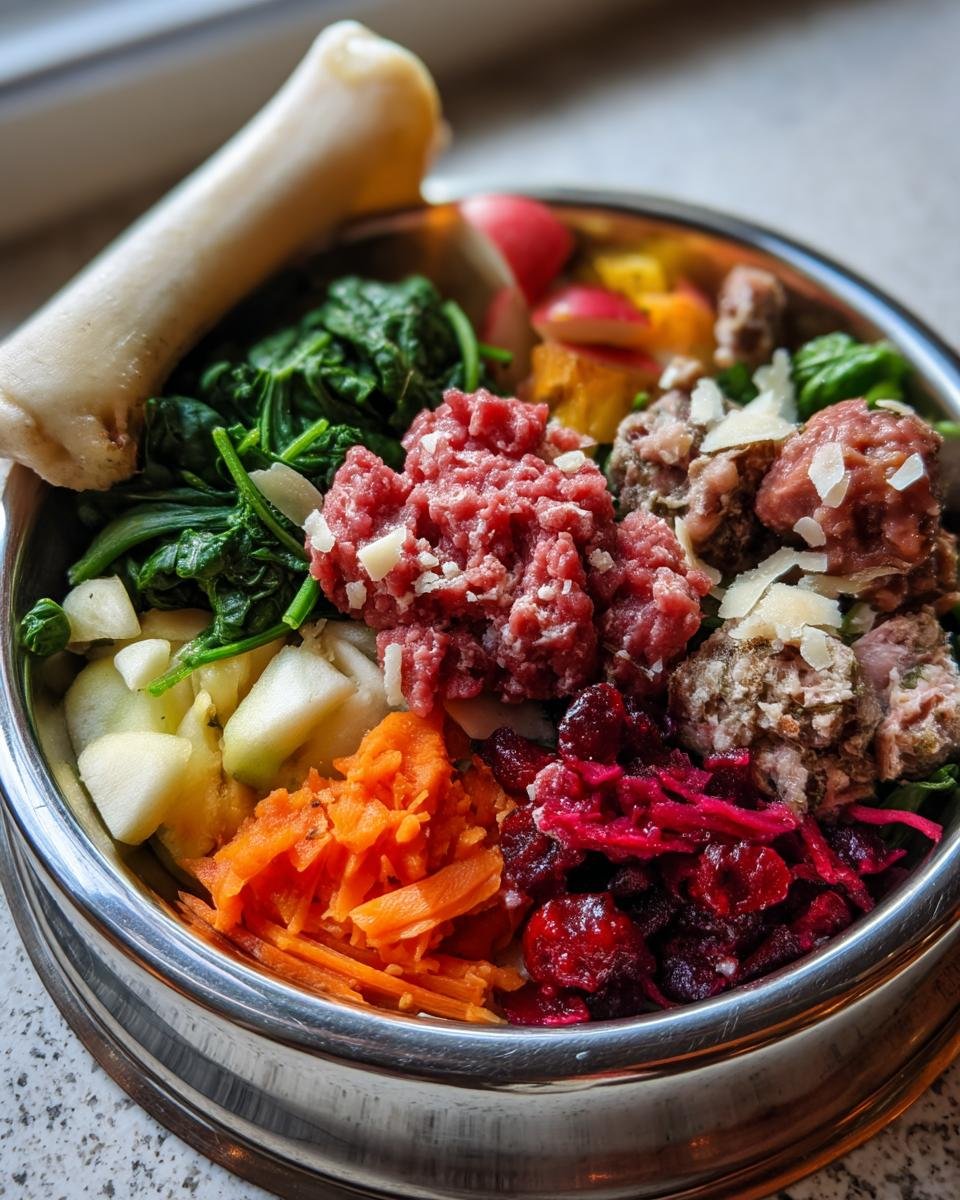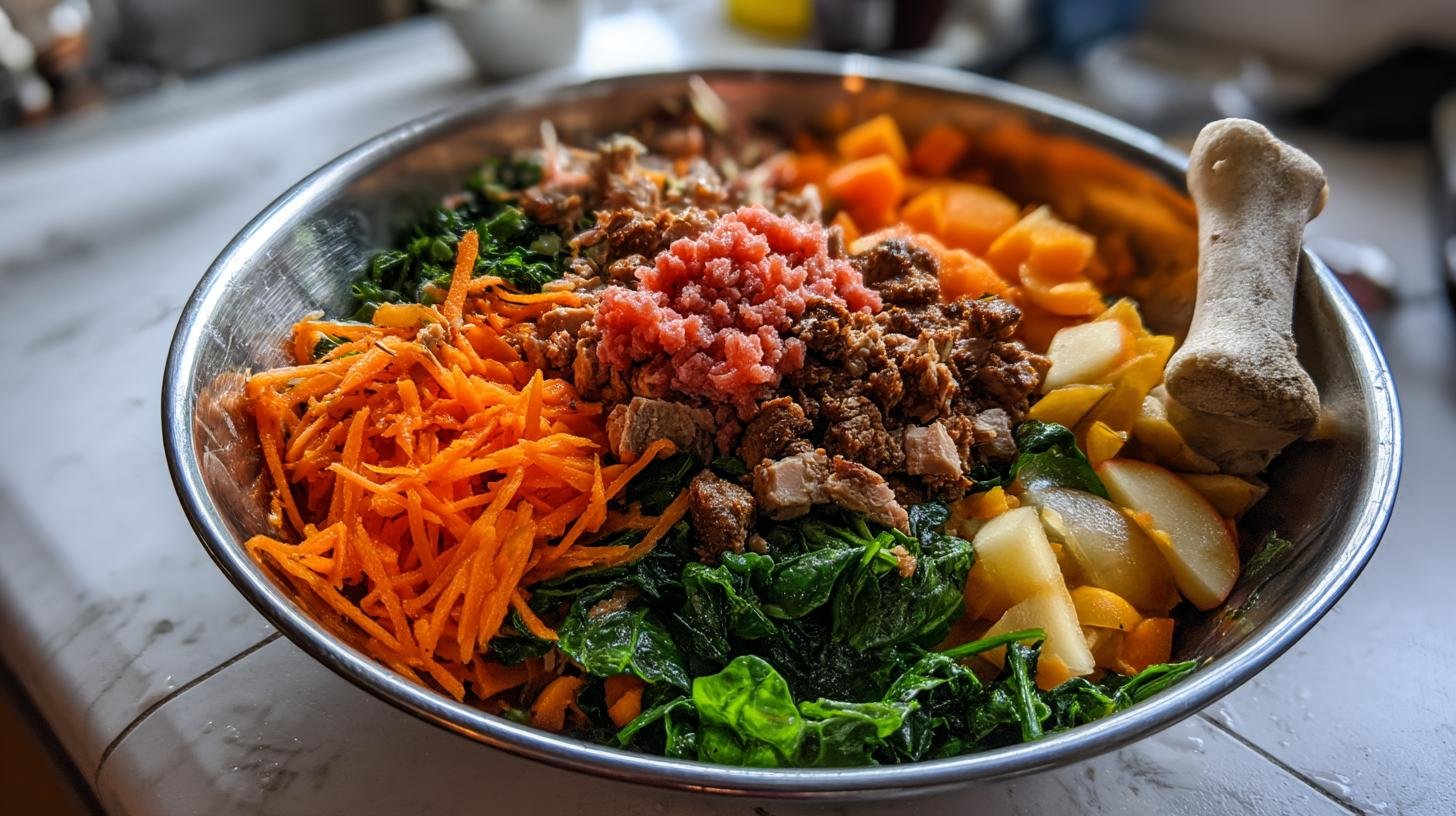Let me tell you about the day I became a raw diet believer. My border collie Luna used to leave half her kibble uneaten, her coat dull as old newspaper. Then we tried a raw chicken wing – just once, as an experiment. Within weeks, her energy exploded like a puppy’s, her fur turned into this ridiculous silky blanket, and her… ahem… backyard deposits? Let’s just say they became impressively compact. But figuring out how to start a raw diet for dogs properly? That took some trial, error, and a very patient veterinarian.
Before we dive in, let me be clear – always chat with your vet first. Luna’s doc helped me avoid rookie mistakes (turns out, you can’t just swap kibble for steak overnight). When done right, raw feeding can feel like unlocking your dog’s inner vitality. I’ve seen it transform senior dogs into tail-wagging time machines and allergy-prone pups into itch-free goofballs.
In this guide, I’ll walk you through the same practical steps that worked for us – from sourcing meats without going broke to balancing nutrients like a pro. You’ll learn why that 80/10/10 ratio matters more than Instagram influencers claim, and how to spot the difference between “transition tummy troubles” and “call the vet now” moments. Let’s get those tails wagging!
Why a Raw Diet Might Be Your Dog’s New Favorite Thing
When I first learned how to start a raw diet for dogs, I didn’t expect the side effects – Luna started doing “zoomies” at age 7 and her teeth went from fuzzy yellow to pearly white. Here’s why so many pups thrive on raw:

Common Misconceptions About Starting a Raw Diet for Dogs
“But isn’t raw meat dangerous?!” my neighbor gasped when she saw me thawing chicken necks. Let’s bust myths faster than Luna inhales a beef heart:
Myth 1: Raw = bacteria fest. Truth? Dogs’ stomachs are literal acid baths designed for raw food. We’re the fragile ones – just wash your hands and surfaces like you would with human-grade meat (which you should absolutely use).
Myth 2: It’s a part-time job. Nope! Once you nail the 80/10/10 ratio (muscle meat/organ meat/veggies+bones), batch-prepping takes 20 minutes weekly. I use ice cube trays for organ meat portions – game changer!
Myth 3: Bones equal vet bills. Cooked bones splinter – raw bones actually clean teeth naturally. Luna’s dentist praised her chompers last checkup. Who’s a good girl?
Ingredients List: What You’ll Need to Start a Raw Diet for Dogs
When I first stared at raw feeding ingredient lists, I nearly quit – so many numbers! But really, it’s simpler than baking cookies. Here’s exactly what goes into Luna’s weekly mix (pro tip: buy in bulk at butcher shops for better deals):
- 2 lbs raw muscle meat – chicken thighs, beef chuck, or turkey breast work best (no seasoning!)
- 1/2 lb raw organ meat – chicken livers for vitamins, beef kidney for minerals (yes, it’s stinky – your dog will adore you)
- 1 cup raw bones – ground chicken necks or whole duck feet for calcium (never cooked – they become dangerous splinter hazards!)
- 1/2 cup veggies – packed measure of finely chopped spinach, grated carrots, or steamed broccoli
- 1/4 cup fruits – chopped apples or smashed blueberries (skip grapes – they’re toxic)
I toss in 1 tbsp fish oil for omega-3s and 1 tsp ground eggshells (bake shells at 300°F first!) as a calcium booster. Pro tip: Pulse veggies in a food processor – dogs digest them better when crushed!
Heads up: Those cooked bones everyone warns about? They’re brittle death traps. Stick to raw, meaty bones that bend slightly when fresh.
My Must-Have Tools for Raw Meal Prep
You don’t need a fancy kitchen, but these four items transformed my raw feeding from chaotic to cruise control:
- Digital kitchen scale – My $15 Amazon find prevents “eyeballing” disasters (trust me, 2oz of liver looks bigger than you’d think!)
- Stainless steel bowls – Plastic scratches trap bacteria, but these beauties survive daily sterilization
- Airtlock containers – I freeze week-long portions in these BPA-free boxes labeled with dates
- Meat grinder (optional) – Lifesaver for tough cuts or picky pups – though I often just chop organs roughly
Pro tip: That blender collecting dust? Perfect for pulverizing veggies into pup-approved mush!
How to Start a Raw Diet for Dogs: Transitioning Steps That Actually Work
Switching Luna to raw felt like teaching a toddler algebra at first – messy and confusing. But breaking it into these steps made all the difference (and saved my kitchen floor from becoming a biohazard zone). Here’s exactly how we nailed the transition:

Consult Your Veterinarian Before Starting a Raw Diet for Dogs
Your vet’s like GPS for this journey – they’ll spot potholes you didn’t see. Luna’s doc ran bloodwork to check her kidney function (crucial for high-protein diets) and suggested adding extra zinc for her breed. Pro tip: Bring a sample of your chosen meats – some vets will recommend parasite testing for game meats.
Choose High-Quality Proteins for Your Dog’s Raw Diet
Chicken thighs became our MVP – affordable and easy to find human-grade. Beef’s great for iron, but fattier cuts can upset sensitive stomachs. I splurge on grass-fed from our farmer’s market monthly. Whatever you pick, yell “restaurant quality!” at the butcher – if you wouldn’t eat it slightly seared, don’t feed it to Fido.
Balance the Diet Correctly When Starting a Raw Diet for Dogs
That 80/10/10 ratio isn’t just trendy – skip it and you’ll get the canine version of hangry. Here’s how I visualize it: 4 chicken thighs (muscle meat), half a beef liver (organ meat), and a handful of pulverized kale+bones = one balanced meal. Skimp on organs? Hello, vitamin deficiencies. Too many veggies? Say goodbye to that shiny coat. It’s like pizza – crust needs toppings, but nobody wants all crust!
Pro tip: I use colored silicone ice trays – red for liver cubes, green for veggie mush. Makes portioning idiot-proof when I’m pre-coffee!
Ingredient Notes and Safe Swaps Even Picky Pups Will Love
When Luna turned up her nose at carrots (rude!), I learned flexibility is key. Here’s how to tweak ingredients without compromising nutrition:
- Veggie haters? Swap carrots for pureed pumpkin – it’s sweeter and aids digestion. Frozen green beans work too for crunch enthusiasts
- Fish oil skeptics (looking at you, Husky owners!) try hemp seeds sprinkled on top – same omega-3 boost, less “dog breath” aftermath
- Can’t find kidneys? Use spleen or testicles (yes, really!) – same nutrient profile, often cheaper at ethnic markets
Heads up: Avoid these like expired treats – grapes/raisins (toxic), onions (anemia risk), and cheap “pet-grade” meats (might contain preservatives). When my friend’s Lab ate garlic-seasoned scraps? Let’s just say the emergency vet bill funded their new swimming pool.
Pro tip: If bones freak you out, use ground eggshells – bake cleaned shells at 300°F for 10 minutes, then crush into powder. 1 tsp = 1,800mg calcium!
How to Start a Raw Diet for Dogs: Feeding Guidelines That Keep Tails Wagging
Portion control became my nemesis when I first learned how to start a raw diet for dogs – turns out, eyeballing meat piles leads to either hangry huskies or chonky chihuahuas! Here’s how we nailed it:

Determine Portion Sizes When Starting a Raw Diet for Dogs
That “2-3% of body weight” rule? It’s gold. Luna’s 50 lbs, so she gets 1 lb daily. Here’s my cheat sheet:
- 10 lb dog → 0.2-0.3 lbs/day (think a chicken thigh + spoonful of organs)
- 30 lb dog → 0.6-0.9 lbs/day (two beef patties + carrot mash)
- 70 lb dog → 1.4-2.1 lbs/day (whole mackerel + sweet potato goop)
Pro tip: Weigh naked pups weekly – if ribs disappear, cut portions by 10%. My food scale stays glued to the counter!
Monitor Your Dog’s Response to the Raw Diet
Within weeks, you’ll spot changes – Luna’s coat went from “meh” to strokable silk. Watch for:
- Poop patrol: Firm logs = good. Runny mess? Too much liver!
- Energy explosion: Zoomies at 2 AM mean you’ve nailed the protein ratio
- Dental bling: Pink gums, white teeth = bone benefits working
When Luna’s eyes got brighter, I knew we’d unlocked raw diet magic.
Adjust the Raw Diet as Your Dog’s Needs Change
Senior pups? Swap hard bones for ground eggshells. Athlete dogs? Boost calories with duck fat. Pregnant mamas? Our vet said +25% food weeks 6-9. I keep a “doggy diary” – tracking weight, energy, and treat bribes needed. Pro tip: Winter portions run 10% bigger – those snow zoomies burn calories!
How to Start a Raw Diet for Dogs: Safety and Storage
Let’s get real – the first time I dropped a raw chicken liver on my kitchen floor, I panicked like I’d spilled nuclear waste. But keeping your pup (and family) safe while storing raw food is simpler than you’d think – just needs a few smart habits!
Handle Raw Ingredients Safely When Starting a Raw Diet for Dogs
I use red cutting boards exclusively for Luna’s meals – same system restaurants use to avoid cross-contamination. After dicing her beef heart, I scrub surfaces with hot soapy water followed by a vinegar spray (1 part vinegar to 3 parts water kills 99% of bacteria). Pro tip: Wear disposable gloves if handling weird organs squicks you out – nobody judges!
My golden rule? Treat dog food prep like human food prep. Would you lick that knife after cutting chicken? Exactly. Wash hands for 20 seconds (hum “Happy Birthday” twice) and sanitize bowls immediately after meals.
Store Raw Dog Food Properly When Starting a Raw Diet for Dogs
Channel your inner raw meal prepper: Portion meals into weekly batches using airtight containers. Freeze at 0°F for up to 3 months – I label everything with dates using painter’s tape. Thaw in the fridge 24 hours before serving (never on the counter – bacteria throw parties in warm temps!).
Leftovers? Toss after 48 hours max. When my freezer died last winter, I learned the hard way – sniff tests lie! When in doubt, bake questionable meat at 165°F (then use it for training treats).
FAQs About Raw Diets That Had Me Scratching My Head (Until I Learned!)
When I first started researching how to start a raw diet for dogs, these questions kept me up at night. Here’s what I’ve learned through trial, error, and one very patient Rottweiler named Bruno:
- “Can puppies eat raw diets?” Absolutely! Luna’s niece started raw at 12 weeks – just use smaller bone pieces (ground is safest) and feed 8-10% of their growing body weight. Our vet said wait until they’re weaned, though – no raw for milk-drunk babies!
- “What if Fido turns up his nose?” Been there! Try a 24-hour fast (healthy dogs can handle it), then offer room-temp meat. My friend’s Shih Tzu caved after I rubbed salmon oil on chicken feet – dogs are suckers for stinky bribes.
- “Is mixing kibble with raw safe?” Ugh, the great debate! I did this during Luna’s transition, but her tummy revolted. Vets say different digestion rates can cause issues – better to separate meals by 6+ hours if you must do both.
Pro tip: For picky eaters, warm the meat slightly (not cook!) to release those irresistible smells. My secret weapon? A dash of bone broth poured over the top – works every time!
Nutritional Information
Nutritional values here are ballpark figures from my kitchen experiments – your actual numbers will swing based on whether you’re using chicken thighs vs. venison. Always consult your vet (yes, again!) since your pup’s age, breed, and zoomie levels affect their needs. This isn’t a substitute for professional dietary advice!
Share Your Raw Diet Journey
Your turn! I want to see your pup’s “aha!” moment – that first triumphant chicken neck crunch or their “what IS this broccoli?!” face. Post progress pics in the comments or tag @WildTailsKitchen in your messy meal prep adventures!
Still nervous? Ask anything below – we’ve all been there. P.S. If your dog’s being stubborn about raw, slide into my DMs. My secret sardine oil trick might just save your sanity…
Print
How to Start a Raw Diet for Dogs: 80/10/10 Secret to Healthy Pets
- Total Time: 20 minutes
- Yield: 3-4 days of meals (for a 50-lb dog) 1x
- Diet: Low Lactose
Description
Learn how to transition your dog to a raw diet with simple steps. A raw diet can improve your dog’s health, energy, and digestion. Always consult your vet before making dietary changes.
Ingredients
- 2 lbs raw muscle meat (chicken, beef, or turkey)
- 1/2 lb raw organ meat (liver, kidney)
- 1 cup raw bones (ground or whole)
- 1/2 cup vegetables (spinach, carrots, broccoli)
- 1/4 cup fruits (apples, blueberries)
- 1 tbsp fish oil or omega-3 supplement
- 1 tsp ground eggshells or calcium supplement
Instructions
- Consult your vet to ensure a raw diet suits your dog’s health needs.
- Choose high-quality proteins like chicken, beef, or turkey as the base.
- Balance the diet with 80% muscle meat, 10% organ meat, and 10% vegetables/fruits.
- Weigh portions based on your dog’s size (2-3% of body weight daily).
- Handle raw ingredients safely: wash surfaces and store food properly.
- Introduce the diet gradually over 7-10 days to avoid digestive issues.
- Monitor your dog’s weight, coat, and energy levels for adjustments.
Notes
- Use human-grade meat to reduce contamination risks.
- Avoid cooked bones—they can splinter and harm your dog.
- Add supplements like fish oil for balanced nutrition.
- Freeze portions for up to 3 months or refrigerate for 2-3 days.
- Prep Time: 20 minutes
- Cook Time: 0 minutes
- Category: Dog Food
- Method: Raw Feeding
- Cuisine: Pet Food
Nutrition
- Serving Size: 1 cup (varies by dog weight)
- Calories: 500-700 kcal
- Sugar: 2g
- Sodium: 150mg
- Fat: 35g
- Saturated Fat: 10g
- Unsaturated Fat: 20g
- Trans Fat: 0g
- Carbohydrates: 5g
- Fiber: 2g
- Protein: 45g
- Cholesterol: 120mg

